warning light Alfa Romeo 4C 2020 Owner handbook (in English)
[x] Cancel search | Manufacturer: ALFA ROMEO, Model Year: 2020, Model line: 4C, Model: Alfa Romeo 4C 2020Pages: 156, PDF Size: 3.06 MB
Page 68 of 156
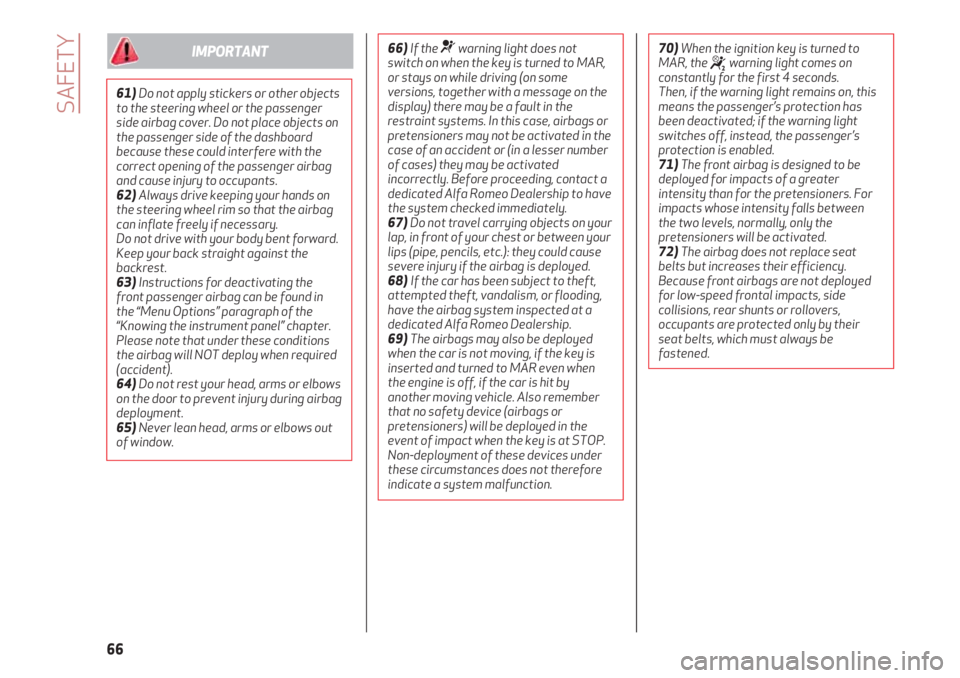
SAFETY
66
61)Do not apply stickers or other objects
to the steering wheel or the passenger
side airbag cover. Do not place objects on
the passenger side of the dashboard
because these could interfere with the
correct opening of the passenger airbag
and cause injury to occupants.
62)Always drive keeping your hands on
the steering wheel rim so that the airbag
can inflate freely if necessary.
Do not drive with your body bent forward.
Keep your back straight against the
backrest.
63)Instructions for deactivating the
front passenger airbag can be found in
the “Menu Options” paragraph of the
“Knowing the instrument panel” chapter.
Please note that under these conditions
the airbag will NOT deploy when required
(accident).
64)Do not rest your head, arms or elbows
on the door to prevent injury during airbag
deployment.
65)Never lean head, arms or elbows out
of window.
IMPORTANT66)If the ¬warning light does not
switch on when the key is turned to MAR,
or stays on while driving (on some
versions, together with a message on the
display) there may be a fault in the
restraint systems. In this case, airbags or
pretensioners may not be activated in the
case of an accident or (in a lesser number
of cases) they may be activated
incorrectly. Before proceeding, contact a
dedicated Alfa Romeo Dealership to have
the system checked immediately.
67)Do not travel carrying objects on your
lap, in front of your chest or between your
lips (pipe, pencils, etc.): they could cause
severe injury if the airbag is deployed.
68) If the car has been subject to theft,
attempted theft, vandalism, or flooding,
have the airbag system inspected at a
dedicated Alfa Romeo Dealership.
69)The airbags may also be deployed
when the car is not moving, if the key is
inserted and turned to MAR even when
the engine is off, if the car is hit by
another moving vehicle. Also remember
that no safety device (airbags or
pretensioners) will be deployed in the
event of impact when the key is at STOP.
Non-deployment of these devices under
these circumstances does not therefore
indicate a system malfunction.70)When the ignition key is turned to
MAR, the
“warning light comes on
constantly for the first 4 seconds.
Then, if the warning light remains on, this
means the passenger’s protection has
been deactivated; if the warning light
switches off, instead, the passenger’s
protection is enabled.
71)The front airbag is designed to be
deployed for impacts of a greater
intensity than for the pretensioners. For
impacts whose intensity falls between
the two levels, normally, only the
pretensioners will be activated.
72)The airbag does not replace seat
belts but increases their efficiency.
Because front airbags are not deployed
for low-speed frontal impacts, side
collisions, rear shunts or rollovers,
occupants are protected only by their
seat belts, which must always be
fastened.
Page 70 of 156
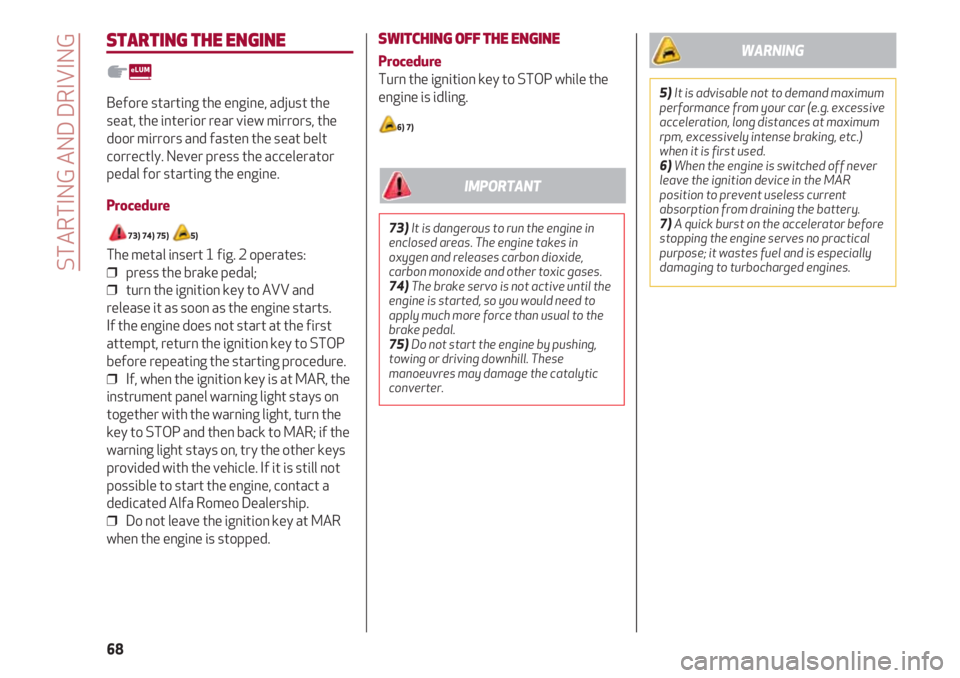
STARTING AND DRIVING
68
STARTING THE ENGINE
Before starting the engine, adjust the
seat, the interior rear view mirrors, the
door mirrors and fasten the seat belt
correctly. Never press the accelerator
pedal for starting the engine.
Procedure
73) 74) 75) 5)
The metal insert 1 fig. 2 operates:
❒ press the brake pedal;
❒ turn the ignition key to AVV and
release it as soon as the engine starts.
If the engine does not start at the first
attempt, return the ignition key to STOP
before repeating the starting procedure.
❒ If, when the ignition key is at MAR, the
instrument panel warning light stays on
together with the warning light, turn the
key to STOP and then back to MAR; if the
warning light stays on, try the other keys
provided with the vehicle. If it is still not
possible to start the engine, contact a
dedicated Alfa Romeo Dealership.
❒ Do not leave the ignition key at MAR
when the engine is stopped.
SWITCHING OFF THE ENGINE
Procedure
Turn the ignition key to STOP while the
engine is idling.
6) 7)
73)It is dangerous to run the engine in
enclosed areas. The engine takes in
oxygen and releases carbon dioxide,
carbon monoxide and other toxic gases.
74)The brake servo is not active until the
engine is started, so you would need to
apply much more force than usual to the
brake pedal.
75)Do not start the engine by pushing,
towing or driving downhill. These
manoeuvres may damage the catalytic
converter.
IMPORTANT
5)It is advisable not to demand maximum
performance from your car (e.g. excessive
acceleration, long distances at maximum
rpm, excessively intense braking, etc.)
when it is first used.
6)When the engine is switched off never
leave the ignition device in the MAR
position to prevent useless current
absorption from draining the battery.
7)A quick burst on the accelerator before
stopping the engine serves no practical
purpose; it wastes fuel and is especially
damaging to turbocharged engines.
WARNING
Page 71 of 156
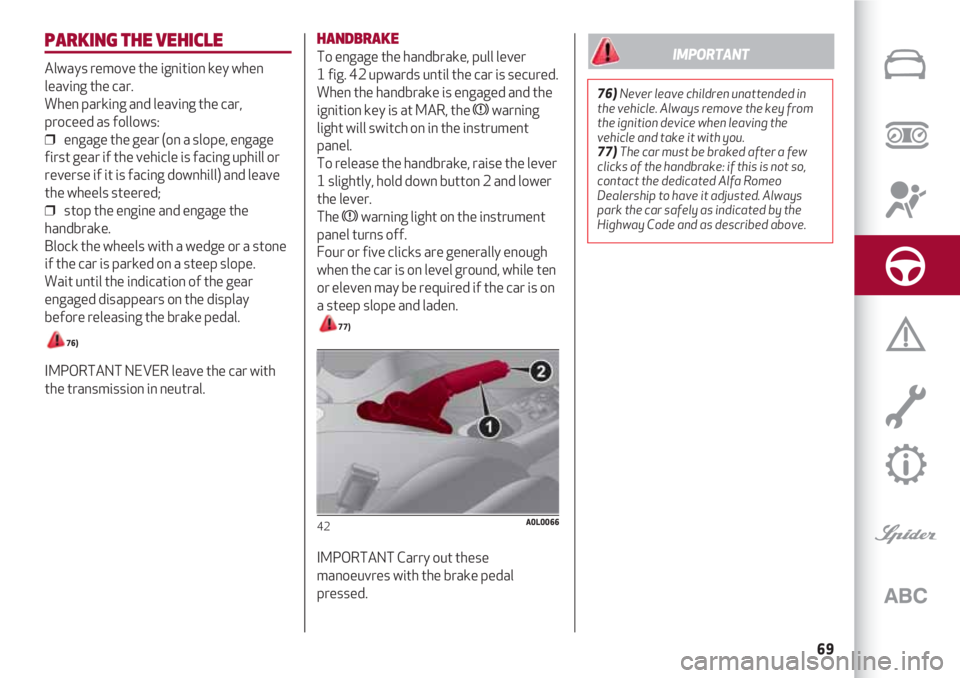
69
PARKING THE VEHICLE
Always remove the ignition key when
leaving the car.
When parking and leaving the car,
proceed as follows:
❒ engage the gear (on a slope, engage
first gear if the vehicle is facing uphill or
reverse if it is facing downhill) and leave
the wheels steered;
❒ stop the engine and engage the
handbrake.
Block the wheels with a wedge or a stone
if the car is parked on a steep slope.
Wait until the indication of the gear
engaged disappears on the display
before releasing the brake pedal.
76)
IMPORTANT NEVER leave the car with
the transmission in neutral.
HANDBRAKE
To engage the handbrake, pull lever
1 fig. 42 upwards until the car is secured.
When the handbrake is engaged and the
ignition key is at MAR, the xwarning
light will switch on in the instrument
panel.
To release the handbrake, raise the lever
1 slightly, hold down button 2 and lower
the lever.
The xwarning light on the instrument
panel turns off.
Four or five clicks are generally enough
when the car is on level ground, while ten
or eleven may be required if the car is on
a steep slope and laden.
77)
IMPORTANT Carry out these
manoeuvres with the brake pedal
pressed.
42A0L0066
76)Never leave children unattended in
the vehicle. Always remove the key from
the ignition device when leaving the
vehicle and take it with you.
77)The car must be braked after a few
clicks of the handbrake: if this is not so,
contact the dedicated Alfa Romeo
Dealership to have it adjusted. Always
park the car safely as indicated by the
Highway Code and as described above.
IMPORTANT
Page 74 of 156

STARTING AND DRIVING
72
The shifting up or down is only permitted
if the engine revs allow it.
STARTING THE ENGINE
To start the engine press the brake pedal:
the system engages neutral (N)
automatically.
After the starting procedure, 1st gear (1)
or reverse (R) can be engaged.
Irrespective of the mode selected
(AUTO/MANUAL), to engage 1st gear or
reverse (R), it is necessary to press the
brake pedal and press the 1 button on the
transmission control panel (or the “+”
steering wheel stalk) to engage 1st gear
or the R button to engage reverse.
When 1st gear is engaged, the system
sets itself to AUTO mode.
Neutral (N) can be engaged again by
pressing the N button with the brake
pedal pressed.
When the 1, N or R buttons are pressed
(or “+” steering wheel stalk is operated)
without pressing the brake pedal, no gear
change request is implemented by the
system.
IMPORTANT Reverse cannot be engaged
by pressing the “-” stalk on the steering
wheel.
Important notes
To start in presence of a gearbox fault
(see “Warning lights and messages”
paragraph in the “Knowing the instrument
panel” chapter), run the
“Delayed start-up” procedure:
turn the key to the AVV position for at
least 7 seconds with the brake depressed
and the engine will start.
The system will remain in “recovery”
condition.
If the engine does not start, contact a
dedicated Alfa Romeo Dealership.
When the driver’s door is opened, the
system activates the hydraulic
components so that they are prepared
for the subsequent engine starting.
MOVING THE CAR
The car can set off both in 1st gear and
reverse (R).
The gears can only be engaged by
pressing the brake pedal. If the brake
pedal is not depressed, the display will
show a dedicated message.It is not possible to set off in a higher gear
than 1st: if this is attempted, the display
shows a dedicated message.
When setting off on a medium-steep
incline, it is advisable to engage the
handbrake.
Engaging 1st gear
Proceed as follows:
❒ press the brake pedal;
❒ press the 1 button on the
transmission control panel;
❒ release the brake pedal and press the
accelerator pedal.
Engaging reverse (R)
Reverse (R) can only be engaged with car
stationary and brake pedal pressed.
Proceed as follows:
❒ press the brake pedal (car completely
stationary);
❒ press button R on the
gearbox panel;
❒ release the brake pedal and press the
accelerator pedal.
When reverse is engaged on some
versions, the system emits an acoustic
signal.
If the brake pedal is not depressed (and
the vehicle is stationary), the display will
show a dedicated message and the
system will automatically engage neutral
(N).
Page 77 of 156
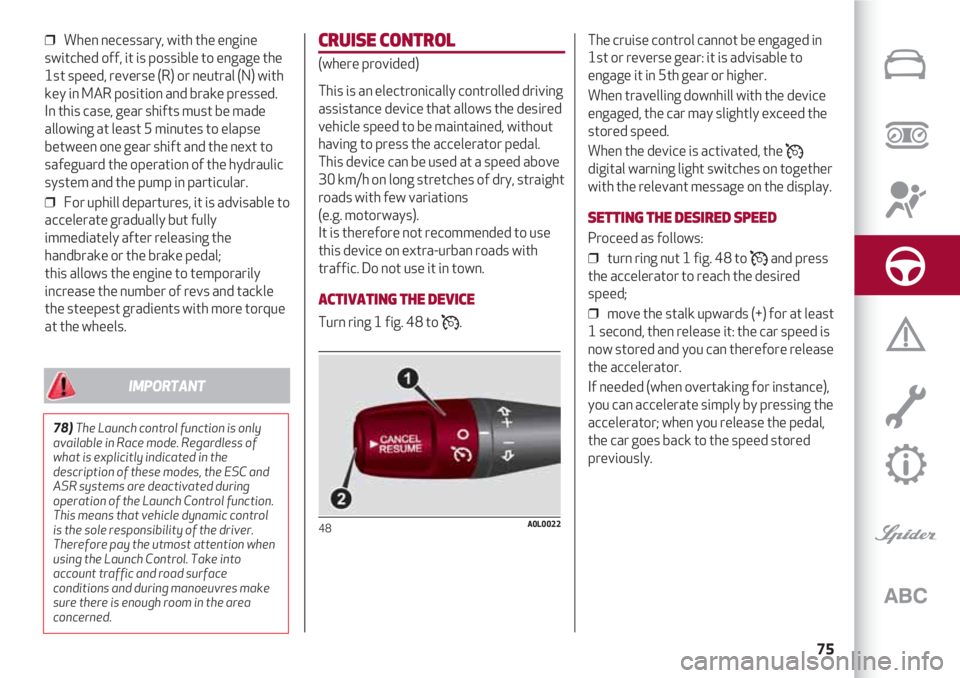
75
❒ When necessary, with the engine
switched off, it is possible to engage the
1st speed, reverse (R) or neutral (N) with
key in MAR position and brake pressed.
In this case, gear shifts must be made
allowing at least 5 minutes to elapse
between one gear shift and the next to
safeguard the operation of the hydraulic
system and the pump in particular.
❒ For uphill departures, it is advisable to
accelerate gradually but fully
immediately after releasing the
handbrake or the brake pedal;
this allows the engine to temporarily
increase the number of revs and tackle
the steepest gradients with more torque
at the wheels.CRUISE CONTROL
(where provided)
This is an electronically controlled driving
assistance device that allows the desired
vehicle speed to be maintained, without
having to press the accelerator pedal.
This device can be used at a speed above
30 km/h on long stretches of dry, straight
roads with few variations
(e.g. motorways).
It is therefore not recommended to use
this device on extra-urban roads with
traffic. Do not use it in town.
ACTIVATING THE DEVICE
Turn ring 1 fig. 48 to .
48A0L0022
78)The Launch control function is only
available in Race mode. Regardless of
what is explicitly indicated in the
description of these modes, the ESC and
ASR systems are deactivated during
operation of the Launch Control function.
This means that vehicle dynamic control
is the sole responsibility of the driver.
Therefore pay the utmost attention when
using the Launch Control. Take into
account traffic and road surface
conditions and during manoeuvres make
sure there is enough room in the area
concerned.
IMPORTANT
The cruise control cannot be engaged in
1st or reverse gear: it is advisable to
engage it in 5th gear or higher.
When travelling downhill with the device
engaged, the car may slightly exceed the
stored speed.
When the device is activated, the
digital warning light switches on together
with the relevant message on the display.
SETTING THE DESIRED SPEED
Proceed as follows:
❒ turn ring nut 1 fig. 48 to and press
the accelerator to reach the desired
speed;
❒ move the stalk upwards (+) for at least
1 second, then release it: the car speed is
now stored and you can therefore release
the accelerator.
If needed (when overtaking for instance),
you can accelerate simply by pressing the
accelerator; when you release the pedal,
the car goes back to the speed stored
previously.
Page 84 of 156
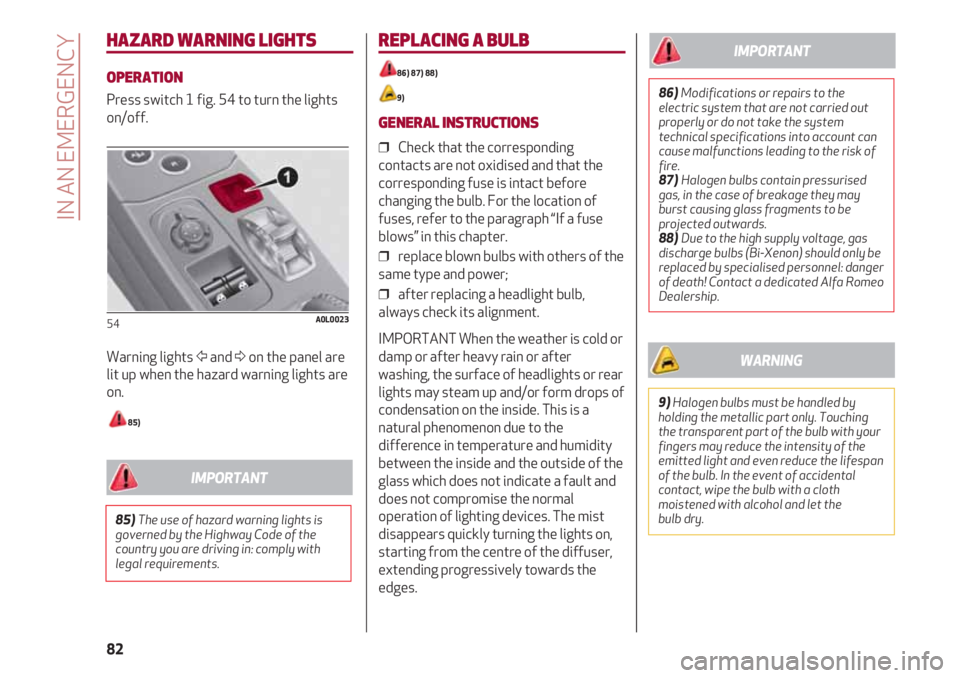
IN AN EMERGENCY
82
HAZARD WARNING LIGHTS
OPERATION
Press switch 1 fig. 54 to turn the lights
on/off.
Warning lights Ÿand Δon the panel are
lit up when the hazard warning lights are
on.
85)
54A0L0023
REPLACING A BULB
86) 87) 88)
9)
GENERAL INSTRUCTIONS
❒ Check that the corresponding
contacts are not oxidised and that the
corresponding fuse is intact before
changing the bulb. For the location of
fuses, refer to the paragraph “If a fuse
blows” in this chapter.
❒ replace blown bulbs with others of the
same type and power;
❒ after replacing a headlight bulb,
always check its alignment.
IMPORTANT When the weather is cold or
damp or after heavy rain or after
washing, the surface of headlights or rear
lights may steam up and/or form drops of
condensation on the inside. This is a
natural phenomenon due to the
difference in temperature and humidity
between the inside and the outside of the
glass which does not indicate a fault and
does not compromise the normal
operation of lighting devices. The mist
disappears quickly turning the lights on,
starting from the centre of the diffuser,
extending progressively towards the
edges.
85)The use of hazard warning lights is
governed by the Highway Code of the
country you are driving in: comply with
legal requirements.
IMPORTANT
86)Modifications or repairs to the
electric system that are not carried out
properly or do not take the system
technical specifications into account can
cause malfunctions leading to the risk of
fire.
87) Halogen bulbs contain pressurised
gas, in the case of breakage they may
burst causing glass fragments to be
projected outwards.
88) Due to the high supply voltage, gas
discharge bulbs (Bi-Xenon) should only be
replaced by specialised personnel: danger
of death! Contact a dedicated Alfa Romeo
Dealership.
IMPORTANT
9)Halogen bulbs must be handled by
holding the metallic part only. Touching
the transparent part of the bulb with your
fingers may reduce the intensity of the
emitted light and even reduce the lifespan
of the bulb. In the event of accidental
contact, wipe the bulb with a cloth
moistened with alcohol and let the
bulb dry.
WARNING
Page 91 of 156
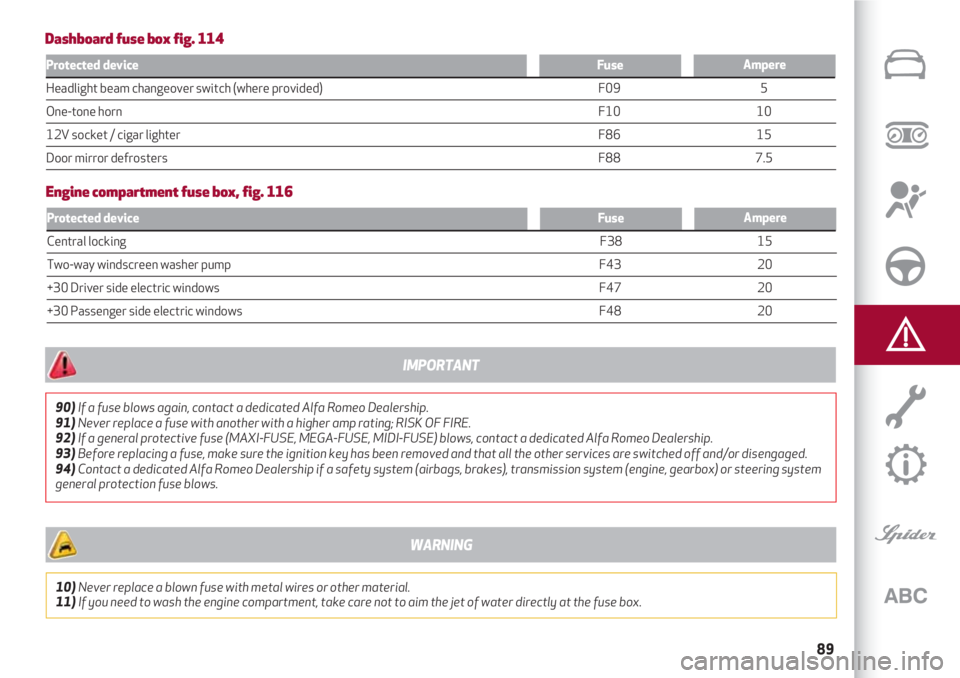
89
Protected deviceAmpereFuse
Headlight beam changeover switch (where provided) F09 5
One-tone horn F10 10
12V socket / cigar lighter F86 15
Door mirror defrosters F88 7.5
Dashboard fuse box fig. 114
Protected deviceAmpereFuse
Central locking F38 15
Two-way windscreen washer pump F43 20
+30 Driver side electric windows F47 20
+30 Passenger side electric windows F48 20
Engine compartment fuse box, fig. 116
90)If a fuse blows again, contact a dedicated Alfa Romeo Dealership.
91)Never replace a fuse with another with a higher amp rating; RISK OF FIRE.
92)If a general protective fuse (MAXI-FUSE, MEGA-FUSE, MIDI-FUSE) blows, contact a dedicated Alfa Romeo Dealership.
93)Before replacing a fuse, make sure the ignition key has been removed and that all the other services are switched off and/or disengaged.
94)Contact a dedicated Alfa Romeo Dealership if a safety system (airbags, brakes), transmission system (engine, gearbox) or steering system
general protection fuse blows.
IMPORTANT
10)Never replace a blown fuse with metal wires or other material.
11)If you need to wash the engine compartment, take care not to aim the jet of water directly at the fuse box.
WARNING
Page 95 of 156
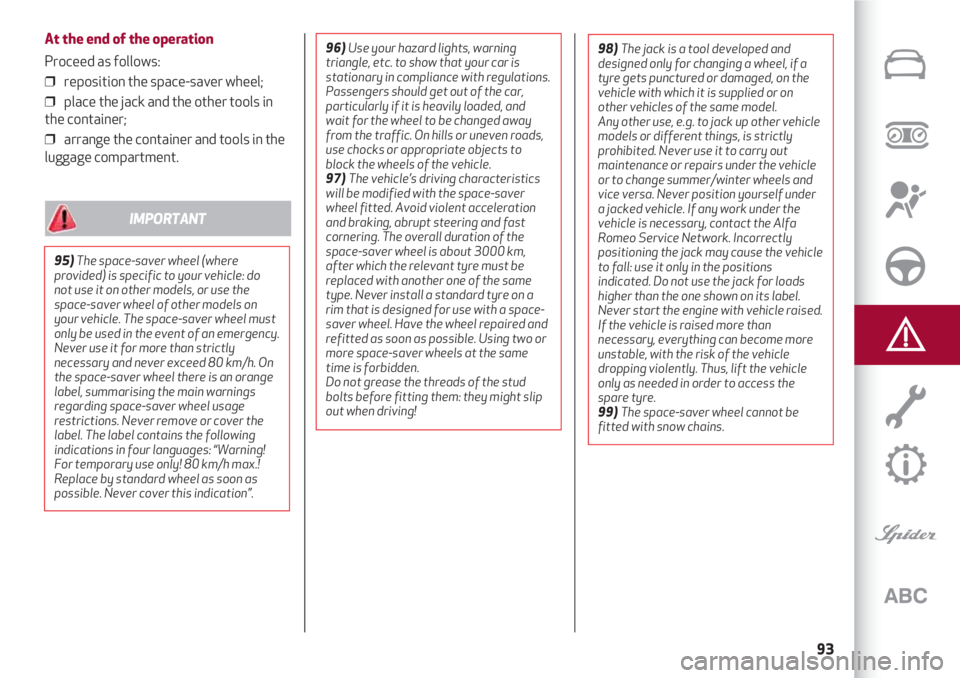
93
At the end of the operation
Proceed as follows:
❒ reposition the space-saver wheel;
❒ place the jack and the other tools in
the container;
❒ arrange the container and tools in the
luggage compartment.
95)The space-saver wheel (where
provided) is specific to your vehicle: do
not use it on other models, or use the
space-saver wheel of other models on
your vehicle. The space-saver wheel must
only be used in the event of an emergency.
Never use it for more than strictly
necessary and never exceed 80 km/h. On
the space-saver wheel there is an orange
label, summarising the main warnings
regarding space-saver wheel usage
restrictions. Never remove or cover the
label. The label contains the following
indications in four languages: “Warning!
For temporary use only! 80 km/h max.!
Replace by standard wheel as soon as
possible. Never cover this indication”.
IMPORTANT
96)Use your hazard lights, warning
triangle, etc. to show that your car is
stationary in compliance with regulations.
Passengers should get out of the car,
particularly if it is heavily loaded, and
wait for the wheel to be changed away
from the traffic. On hills or uneven roads,
use chocks or appropriate objects to
block the wheels of the vehicle.
97) The vehicle’s driving characteristics
will be modified with the space-saver
wheel fitted. Avoid violent acceleration
and braking, abrupt steering and fast
cornering. The overall duration of the
space-saver wheel is about 3000 km,
after which the relevant tyre must be
replaced with another one of the same
type. Never install a standard tyre on a
rim that is designed for use with a space-
saver wheel. Have the wheel repaired and
refitted as soon as possible. Using two or
more space-saver wheels at the same
time is forbidden.
Do not grease the threads of the stud
bolts before fitting them: they might slip
out when driving!98) The jack is a tool developed and
designed only for changing a wheel, if a
tyre gets punctured or damaged, on the
vehicle with which it is supplied or on
other vehicles of the same model.
Any other use, e.g. to jack up other vehicle
models or different things, is strictly
prohibited. Never use it to carry out
maintenance or repairs under the vehicle
or to change summer/winter wheels and
vice versa. Never position yourself under
a jacked vehicle. If any work under the
vehicle is necessary, contact the Alfa
Romeo Service Network. Incorrectly
positioning the jack may cause the vehicle
to fall: use it only in the positions
indicated. Do not use the jack for loads
higher than the one shown on its label.
Never start the engine with vehicle raised.
If the vehicle is raised more than
necessary, everything can become more
unstable, with the risk of the vehicle
dropping violently. Thus, lift the vehicle
only as needed in order to access the
spare tyre.
99) The space-saver wheel cannot be
fitted with snow chains.
Page 98 of 156
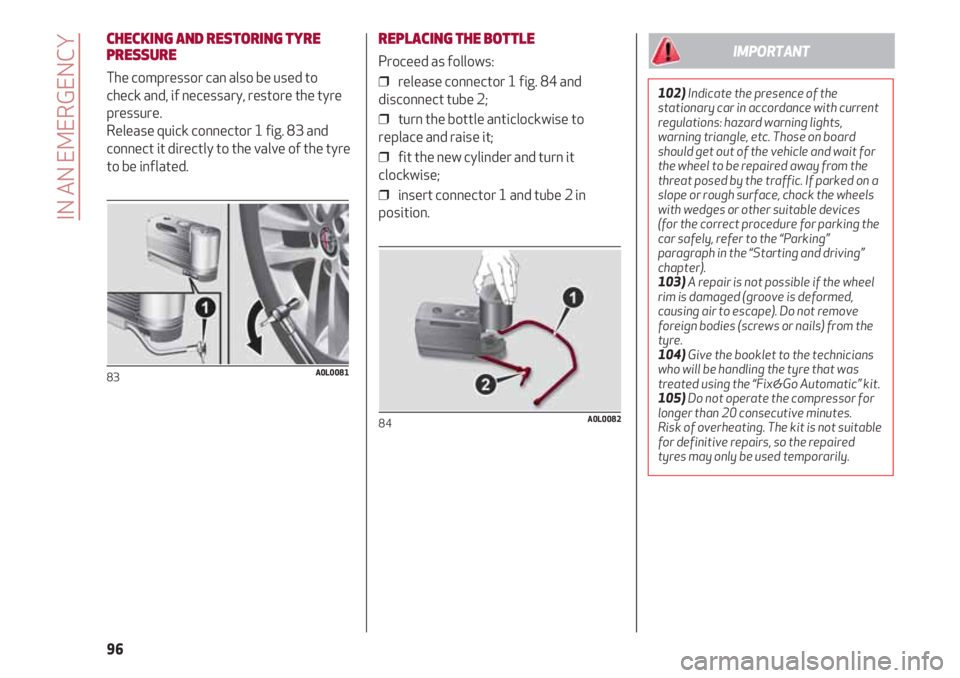
IN AN EMERGENCY
96
CHECKING AND RESTORING TYRE
PRESSURE
The compressor can also be used to
check and, if necessary, restore the tyre
pressure.
Release quick connector 1 fig. 83 and
connect it directly to the valve of the tyre
to be inflated.
83A0L0081
REPLACING THE BOTTLE
Proceed as follows:
❒ release connector 1 fig. 84 and
disconnect tube 2;
❒ turn the bottle anticlockwise to
replace and raise it;
❒ fit the new cylinder and turn it
clockwise;
❒ insert connector 1 and tube 2 in
position.
84A0L0082
102)Indicate the presence of the
stationary car in accordance with current
regulations: hazard warning lights,
warning triangle, etc. Those on board
should get out of the vehicle and wait for
the wheel to be repaired away from the
threat posed by the traffic. If parked on a
slope or rough surface, chock the wheels
with wedges or other suitable devices
(for the correct procedure for parking the
car safely, refer to the “Parking”
paragraph in the “Starting and driving”
chapter).
103)A repair is not possible if the wheel
rim is damaged (groove is deformed,
causing air to escape). Do not remove
foreign bodies (screws or nails) from the
tyre.
104)Give the booklet to the technicians
who will be handling the tyre that was
treated using the “Fix&Go Automatic” kit.
105)Do not operate the compressor for
longer than 20 consecutive minutes.
Risk of overheating. The kit is not suitable
for definitive repairs, so the repaired
tyres may only be used temporarily.
IMPORTANT
Page 99 of 156
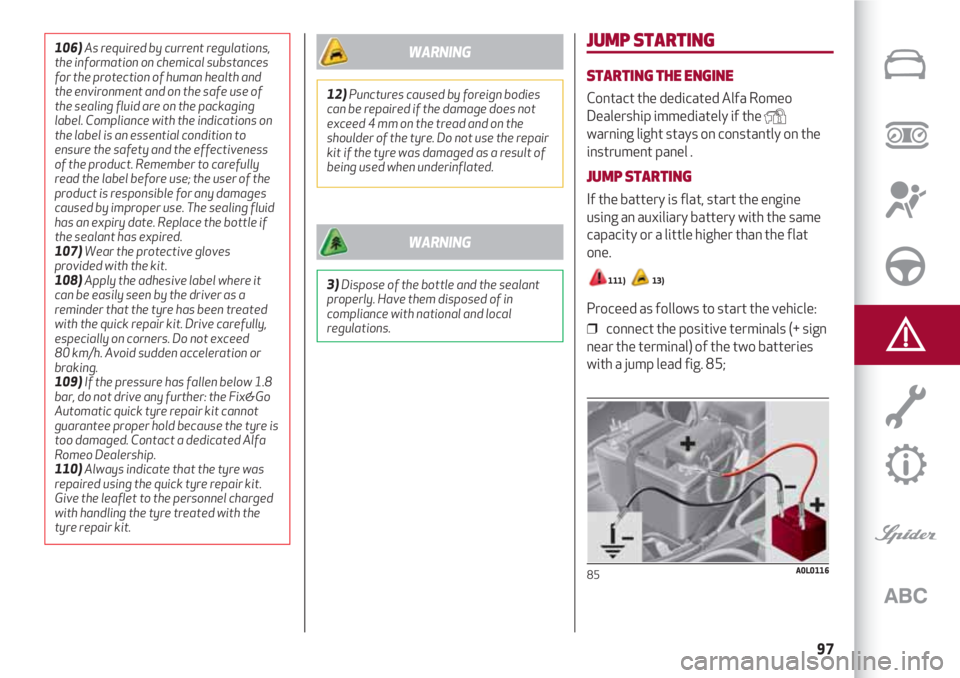
97
JUMP STARTING
STARTING THE ENGINE
Contact the dedicated Alfa Romeo
Dealership immediately if the
Ywarning light stays on constantly on the
instrument panel .
JUMP STARTING
If the battery is flat, start the engine
using an auxiliary battery with the same
capacity or a little higher than the flat
one.
111) 13)
Proceed as follows to start the vehicle:
❒ connect the positive terminals (+ sign
near the terminal) of the two batteries
with a jump lead fig. 85;
85A0L0116
106)As required by current regulations,
the information on chemical substances
for the protection of human health and
the environment and on the safe use of
the sealing fluid are on the packaging
label. Compliance with the indications on
the label is an essential condition to
ensure the safety and the effectiveness
of the product. Remember to carefully
read the label before use; the user of the
product is responsible for any damages
caused by improper use. The sealing fluid
has an expiry date. Replace the bottle if
the sealant has expired.
107)Wear the protective gloves
provided with the kit.
108)Apply the adhesive label where it
can be easily seen by the driver as a
reminder that the tyre has been treated
with the quick repair kit. Drive carefully,
especially on corners. Do not exceed
80 km/h. Avoid sudden acceleration or
braking.
109)If the pressure has fallen below 1.8
bar, do not drive any further: the Fix&Go
Automatic quick tyre repair kit cannot
guarantee proper hold because the tyre is
too damaged. Contact a dedicated Alfa
Romeo Dealership.
110)Always indicate that the tyre was
repaired using the quick tyre repair kit.
Give the leaflet to the personnel charged
with handling the tyre treated with the
tyre repair kit.
12)Punctures caused by foreign bodies
can be repaired if the damage does not
exceed 4 mm on the tread and on the
shoulder of the tyre. Do not use the repair
kit if the tyre was damaged as a result of
being used when underinflated.
WARNING
3)Dispose of the bottle and the sealant
properly. Have them disposed of in
compliance with national and local
regulations.
WARNING